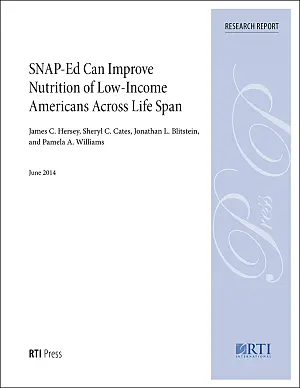SNAP-Ed can improve nutrition of low-income Americans across life span
By James C. Hersey, Sheryl C. Cates, Jonathan L. Blitstein, Pamela A. Williams.
June 2014 Open Access Peer Reviewed
DOI: 10.3768/rtipress.2014.RR.0023.1406
Abstract
Nutrition education in the Supplemental Nutrition Assistance Program (SNAP-Ed) is designed to promote healthy eating behaviors in a low-income target population. In particular, SNAP-Ed programming encourages participants to increase consumption of fruit and vegetables and switch to lower fat dairy products. With funding from the U.S. Department of Agriculture’s Food and Nutrition Service (FNS), we independently evaluated eight programs that were selected as possible model SNAP-Ed programs. Our evaluations used robust research designs (experimental or quasi-experimental), similar primary outcome measures across the studies, and statistical analyses to account for clustering of participants within settings. These evaluations found a significant effect in outcomes for four programs: one in child care settings, two in elementary schools, and one in senior centers, suggesting that SNAP-Ed has the potential to be effective for some individuals across all age groups. Additionally, the study findings suggest that the maturity of the program (that is, experience in implementing the program over time) may make nutrition education more effective. Future studies should assess the longer-term effects on nutrition behaviors and sustainability of SNAP-Ed programs for preschool- and elementary-aged children, adults, and senior citizens.
![]() © 2025 RTI International. This work is licensed under a Creative Commons Attribution-NonCommercial-NoDerivatives 4.0 International License.
© 2025 RTI International. This work is licensed under a Creative Commons Attribution-NonCommercial-NoDerivatives 4.0 International License.
To contact an author or seek permission to use copyrighted content, contact our editorial team


